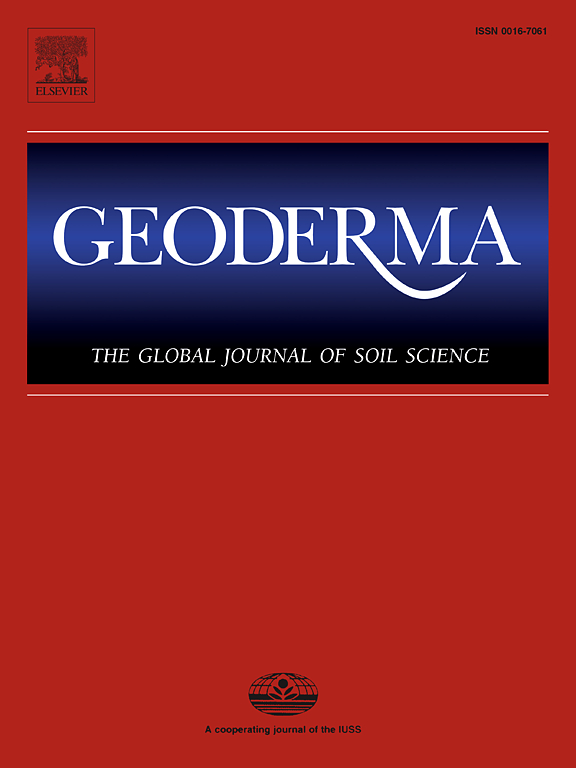在亚高山次生演替中,原生生物群落与非生物土壤因子相关,而与资源、猎物或捕食者无关
IF 5.6
1区 农林科学
Q1 SOIL SCIENCE
引用次数: 0
摘要
原生生物是土壤微食物网的关键组成部分,影响着微生物的功能和养分循环。虽然非生物土壤因子一直驱动原生群落,但自下而上(资源)和自上而下(捕食者)力量的作用仍未得到充分研究。缺乏对这些驱动因素的综合研究限制了我们对原生生物群落变化的理解。为了填补这一空白,我们研究了中国西南亚高山演替(草地、灌丛、次生林、原始林),利用18S rRNA基因测序对原生群落进行了评估。我们特别测试了基础植物资源、食物网成分和非生物土壤因子如何塑造原生生物群落及其功能群(吞噬型、寄生型、光养型)。结果表明:在次生林演替过程中,原生生物多样性总体呈下降趋势,以次生林次生林最低;除寄生原生生物与植物资源和无脊椎动物多样性相关外,非生物土壤因子(特别是土壤水分、全磷和pH)与原生生物群落组成的相关性较强,而植物资源、猎物和捕食者与植物资源和无脊椎动物多样性的相关性较弱。与光养型原生生物相比,吞噬型和寄生型原生生物群落组成在演替过程中变化更为明显。我们的研究结果强调了非生物土壤因子在形成原生生物群落中的主导作用,这可能导致地上(植物)和地下(原生生物)多样性模式的脱钩。此外,原生生物群落的营养水平越高,对演替越敏感,表明生态系统发展过程中土壤微食物网的功能重构。这种综合视角增强了我们对土壤原生生物群落的理解,强调了跨环境梯度塑造地下生态系统的非生物和生物因素之间的相互作用。本文章由计算机程序翻译,如有差异,请以英文原文为准。
Protist communities are correlated with abiotic soil factors, but not resources, prey, or predators along a subalpine secondary succession
Protists are pivotal components of soil micro-food webs, influencing microbial functioning and nutrient cycling. While abiotic soil factors consistently drive protist communities, the roles of bottom-up (resources) and top-down (predators) forces remain understudied. The lack of integrative studies on these drivers constrains our understanding of changes in protistan communities. To fill this gap, we investigated a subalpine succession (grassland, shrubland, secondary forest, primary forest) in southwestern China, using 18S rRNA gene sequencing to assess protist communities. We specifically tested how basal plant resources, food web components, and abiotic soil factors shape protist communities and their functional groups (phagotrophic, parasitic, phototrophic). The results showed that overall protist diversity decreased during secondary succession, being lowest in secondary birch forests. Abiotic soil factors, especially soil moisture, total phosphorus, and pH, were strongly correlated with protist community composition, while plant resources, prey, and predators showed weaker associations, except for parasitic protists, which were also associated with plant resources and invertebrate diversity. The community composition of phagotrophic and parasitic protists exhibited more pronounced changes along the succession compared to phototrophic protists. Our findings highlight the dominant role of abiotic soil factors in shaping protist communities, which may lead to a decoupling of above- (plant) and belowground (protist) diversity patterns. Moreover, higher trophic levels within protist communities showed greater sensitivity to succession, indicating functional restructuring in soil micro-food webs during ecosystem development. This integrative perspective enhances our understanding of soil protist communities, highlighting the interactions between abiotic and biotic factors that shape belowground ecosystems across environmental gradients.
求助全文
通过发布文献求助,成功后即可免费获取论文全文。
去求助
来源期刊

Geoderma
农林科学-土壤科学
CiteScore
11.80
自引率
6.60%
发文量
597
审稿时长
58 days
期刊介绍:
Geoderma - the global journal of soil science - welcomes authors, readers and soil research from all parts of the world, encourages worldwide soil studies, and embraces all aspects of soil science and its associated pedagogy. The journal particularly welcomes interdisciplinary work focusing on dynamic soil processes and functions across space and time.
 求助内容:
求助内容: 应助结果提醒方式:
应助结果提醒方式:


